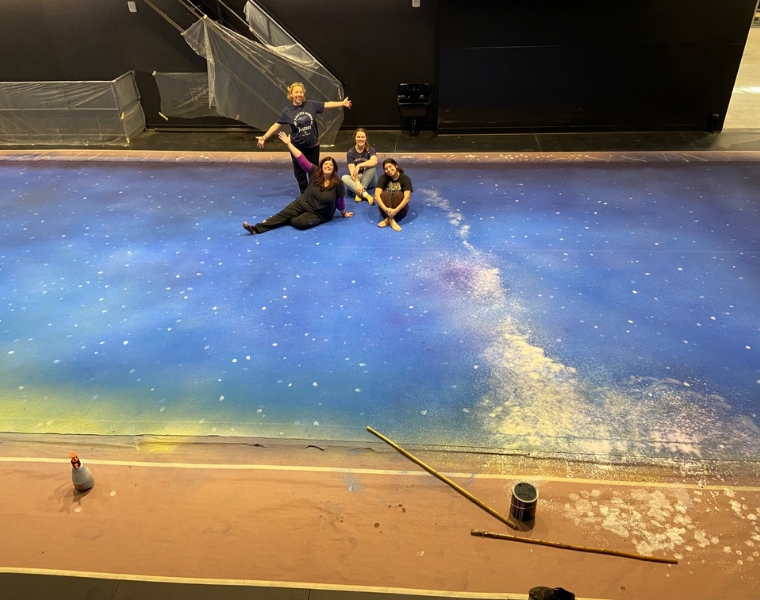Whether you enjoy watching movies from the comfort of your home or catching live shows at venues such as Playhouse Square, theater allows you to experience diverse perspectives through the art of storytelling. But have you ever stepped back to consider how the overall artistry of the performance came to be?
From creating background scenery to managing lighting and props, set designers help immerse audience members into the world of the stories told by transforming the most ordinary spaces into one-of-a-kind experiences that portray critical aspects of the narrative.

In recognition of World Theatre Day (March 27), The Daily spoke with Jill Davis, an associate professor and scenic designer at Case Western Reserve University’s Department of Theater. With over 12 years of professional experience in set design throughout the Cleveland area—including at Cleveland Play House—she’s now lending her artistic touch to the department’s spring production of Almost, Maine, a romantic comedy directed by David Vegh.
Read on to find out what Davis thinks are the fundamental aspects of designing theatrical production sets on campus and get a behind-the-scenes look at the play’s background visuals.
Answers have been lightly edited for clarity and length.
1. What led you to pursue a career in set design?
Painting sets led to designing them, so I pursued my [Master of Fine Arts] in set design at Temple University. The first 12 years of my career were mostly as a scenic artist painting sets, and I gradually designed more and more.
2. What is your thought process as a set designer? What are important aspects to keep in mind when designing a set?
The set is not a piece of art that stands alone. [It] has to help tell the story and set the tone of the play, be it realistic, theatrical, abstract or even magical. I meet with the director often to talk about what we want to say to the audience and how the director wants to use the set. I also think about the themes in the play, the action and the puzzle of fitting it all into the space.
3. What are some challenges you experience as a set designer?
The variety of spaces [where] we perform often seems to be the biggest challenge. Every theater is a different size and shape and sometimes my challenge is to make a small space feel larger, or a large space feel more intimate.
Almost, Maine is a more intimate play with only two (or three) actors in each scene, but we wanted to make the night sky feel as expansive as possible. At the same time, each scene is in a unique location, so the various sets all need to be able to change easily and fit on the stage. Thank goodness we are in the new Roe Green Theatre with plenty of wing space to fit this much scenery.
4. What is your favorite part of being a scenic designer for Almost, Maine?
My favorite part of designing every show is collaborating with different directors, designers, technicians and actors. I’ve worked with many of the designers and technicians on Almost, Maine before, but there are always new students in different roles.
My favorite part about this particular design is the backdrop I painted with the students. We don’t do backdrops very often because they take up a lot of space, but I especially love painting them.
5. What is your favorite production that you have designed sets for at the Maltz Performing Arts Center?
We have only been in the Maltz Performing Arts Center for less than two years, so I have only designed four sets [including, Arcadia, Blood at the Root, Cymbeline and Almost, Maine] here so far. I think Blood at the Root was my favorite design because I tried something new by applying fabric to texture the wall of the set, making a somewhat realistic-looking building facade more abstract and layered with meaning.
6. What are your favorite aspects of the new theater facilities MPAC offers? How do they benefit students?
The Maltz Center is such a fantastic upgrade for the theater department. The size of the Roe Green Theatre stage and wing space is fantastic, and the automated fly system is amazing. The sheer size of [the scene shop] makes it easier for us to have more students working on productions because there is more room to build.
The Kalberer Black Box Theatre lets us do smaller shows with a different audience configuration that presents new challenges to designing and performing. Student groups IMPROVment and [Players’ Theatre Group] are also using the Kalberer Theatre for their shows, which is great. In [Eldred Hall], we weren’t able to share the space because we performed all four of our productions in one theater and had to use the space to build because the shop was too small.
Starting Friday, April 14, at 7:30 p.m., members of the Case Western Reserve University community can experience the full set transformation of Almost, Maine at the Maltz Center’s Roe Green Theatre. To purchase tickets, visit the Maltz Center’s website.


